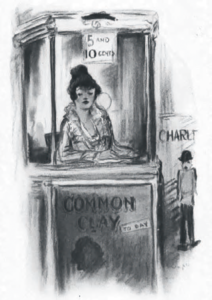I can’t remember exactly when the cinematic past became palpable for me. It was probably sometime in the late Fifties or early Sixties, when the mix of television screenings, museum revivals, film festivals, and cultist publications here and abroad crystallized into a revisionist film culture. Until that time, the experience of moviegoing had been free of the stigma of culture. There were no courses in the subject, no obligations, and no imperatives. We went to the movies and came back home. The movies themselves came and went and almost never returned. Old movies, like old cars, were products for consumption, to be discarded for newer models that supposedly had all the latest improvements in design and technology.
I remember seeing the 1937 movie Stage Door in the mid-Forties. The audience tittered at the obsolete long skirts and curled hairdos. I saw the same movie in the mid-Seventies, and the audience sat enthralled as obsolescence was transformed by time into history—just one movie out of thousands that are available for reconsideration, but symptomatic of a new situation in which old movies have established a living presence in our consciousness. Nonetheless, there are still critics who seem determined to bury the past as they overpraise many of the new releases—as if a revolution in taste were occurring every month or thereabouts. To these hyperbolic modernists I would recommend a semblance of historical perspective. In any event, it is too late for us to regain our innocence as moviegoers. We must learn to live with the past even at the risk of seeming pedantic.
 The more things change, as the French say, and in movies as in everything else each age considers itself superior to and more sophisticated than the previous one. The Edwardians snickered at the Victorians, and the Georgians snickered at the Edwardians. Similarly, the makers of the early talkies dismissed the silents as an embarrassment of wild-eyed emoting. The later talkies dismissed the early talkies. The Forties prided themselves on their increased social consciousness, the Fifties on their perceptive cynicism, the Sixties on their anguished absurdism; the Seventies now flaunt their noble nihilism.
The more things change, as the French say, and in movies as in everything else each age considers itself superior to and more sophisticated than the previous one. The Edwardians snickered at the Victorians, and the Georgians snickered at the Edwardians. Similarly, the makers of the early talkies dismissed the silents as an embarrassment of wild-eyed emoting. The later talkies dismissed the early talkies. The Forties prided themselves on their increased social consciousness, the Fifties on their perceptive cynicism, the Sixties on their anguished absurdism; the Seventies now flaunt their noble nihilism.
It is curious, however, that as we have become less naïve (or perhaps less optimistic) about the power of any art form or medium to change the course of history, the movies have lost much of their easy rapport with audiences. This does not mean that movies are better or worse than they used to be, but rather that cinema has yielded most of its sociological aspirations to television, and thus is no longer the medium of record and reality. The newsreels have disappeared into the tube, and even our fictional entertainment films have generally abandoned the visual syntax by which even the most far-fetched stories were once inserted into a supposedly real world. Whereas old Hollywood used to give us an expressive idea of reality, new Hollywood gives us an extended image. The whole world is now a set, and all its people are extras.
The old movies look different today. For the most part, the old moviemakers imagined that their product was perishable but that their industry would endure. The medium would live, but their movies would die. But this is precisely what makes old movies so enthralling. They seize the moment in which they are made and hang on for dear life. In responding to what they think are the public’s yearnings, they help shape these yearnings.
What is interesting is that, through most of the history of the movies, the medium was considered to be in a state of mutation. Only recently has it become apparent that there is a definite limit to how far cinematic forms can be stretched. Strangely, when movies were much more restricted by censorship and convention than they are now, they were also much more optimistic about their own future development. It is this very optimism which makes old movies so poignant today.
From “The Myth of Old Movies,” which appeared in the September 1975 issue of Harper’s Magazine.






















































































